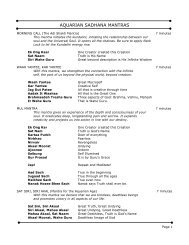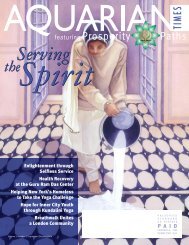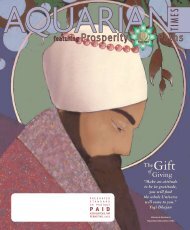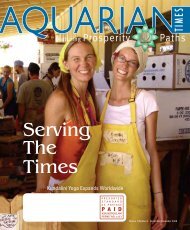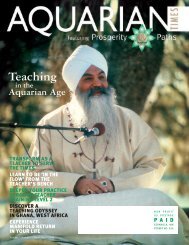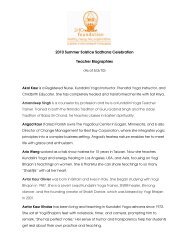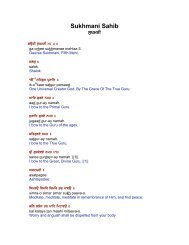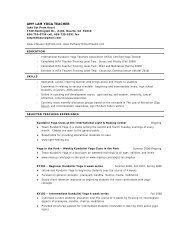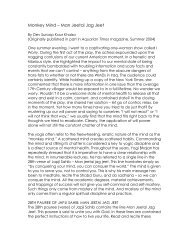July 2006 - 3HO
July 2006 - 3HO
July 2006 - 3HO
You also want an ePaper? Increase the reach of your titles
YUMPU automatically turns print PDFs into web optimized ePapers that Google loves.
y HIV disease are not solely dependent on<br />
the achievements of medical treatment. In<br />
the early years of the AIDS epidemic, Drs.<br />
George Solomon and Lydia Temoshok found<br />
that long-term survivors of AIDS had certain<br />
psychological traits in common, including<br />
what health psychologists call self-efficacy—<br />
the belief that what you do makes a difference.<br />
A few years later, Dr. Robert Ramien from<br />
Columbia University found that long-term nonprogressors—people<br />
living with HIV infection<br />
but not showing symptoms—had strong<br />
self-efficacy profiles. Other researchers have<br />
shown that self-efficacy plays a pivotal role<br />
in the enhancement of the immune system,<br />
in health behavior, and in the quality of life<br />
in people with cancer and also in those with<br />
diabetes. Health educators now understand<br />
that information alone is not sufficient to<br />
create and maintain behavior change. People<br />
must also believe that they can actually make<br />
a change and that change makes a difference.<br />
The good news? The practice of meditation<br />
improves self-efficacy. Clinically I have<br />
seen evidence of this in hundreds of clients<br />
across a variety of medical conditions, and have conducted a study<br />
demonstrating that meditation practice improves self-efficacy in people<br />
living with HIV. Because strengthening self-efficacy is vital to hope, to<br />
changing health behavior, to adherence to medical treatment, to energy,<br />
mood, and quality of life, we now include the practice of meditation in<br />
every class we offer to people recovering their health, no matter what<br />
the diagnosis.<br />
We showed promising results with our Kundalini Yoga for Living<br />
with Diabetes program in 2004 and 2005. Participants told us they<br />
experienced improved quality of life and a greater ability to handle<br />
stress. Their glucose levels and A1C 1 scores were lower and more<br />
stable, with most participants gaining benefit from their very first<br />
class. Our outcome measures backed them up: there was statistically<br />
significant improvement in vitality, and a significant reduction in anxiety,<br />
depression, anger, and fatigue.<br />
Ruby continues, “Receiving a diagnosis of a chronic or life-threatening<br />
illness is one of life’s biggest shocks. It stopped me right in my tracks<br />
and jolted me from living life on automatic pilot. Meditation practice<br />
gave me more than the relief from anxiety that I had sought. It awakened<br />
in me the understanding that there is something more to be healthy for<br />
than just my career. The cancer diagnosis gave me a kick in the behind;<br />
yet it was the meditation practice that woke me up to the true value of my<br />
life. I could have just gone through the treatment protocol and removed<br />
the cancer. If I had done only that, then I may have been cancer-free but<br />
I would still be anxious and depressed and driven to keep measuring my<br />
self-worth by my career advancements. Instead, practicing meditation<br />
unlocked my real gifts, gave me the vitality to create a new future, and<br />
helped me garner the inner support to sustain it. It opened in me a deep<br />
desire to change how I had been living my life.”<br />
Filmmaker Carolyn Speranza had been struggling with stress-related<br />
health problems for years until she started to practice meditation. She<br />
found that as her anxiety lessened, her self-efficacy strengthened, and<br />
her health improved. Encouraged by her own experiences, she made a<br />
film about the effects of meditation called Sight of Stillness, in which<br />
meditators describe how meditation practice affects their lives. For the<br />
premiere screening of the film she hosted a meditation symposium at<br />
the Carnegie Science Center in Pittsburgh, Pennsylvania, and invited me<br />
to share with participants what people with illness experience from their<br />
meditation practice. We told them what our clients have told us, that<br />
meditation practice gives:<br />
• Hope for a return to health.<br />
• A sense of what is possible; from this, I can<br />
explore what is available to me.<br />
• Connection, support. I know and feel that I am<br />
not alone in this.<br />
• Peacefulness, freedom from worry or<br />
uncertainty about the future.<br />
• Joy to be alive right now.<br />
• Calm, to just be in the present moment.<br />
• Clarity to make decisions and confidence to<br />
carry them out.<br />
• Energy to enjoy life.<br />
• Self-efficacy to take action. I believe<br />
in myself now.<br />
• Self-trust to be comfortable in<br />
the face of uncertainty.<br />
• Inner guidance to know what is my path.<br />
• Sacredness to meet life and death<br />
with joy and peace.<br />
• An awareness of my future.<br />
Shanti Shanti Kaur Khalsa, Ph.D., is director of the Guru Ram Das Center<br />
for Medicine & Humanology, a nonprofit organization providing Kundalini<br />
Yoga to persons with chronic or life-threatening illness. A charter member<br />
of the International Association of Yoga Therapists, she lectures widely<br />
on the behavioral, psychological, and spiritual aspects of getting and<br />
staying well. Email healthnow@grdcenter.org, or visit our website, www.<br />
grdcenter.org.<br />
1 A measure of blood glucose over a 3 to 4 month period.<br />
18 Aquarian Times featuring Prosperity Paths<br />
<strong>July</strong>.AT.6.indd 18 6/6/06 2:31:49 PM



